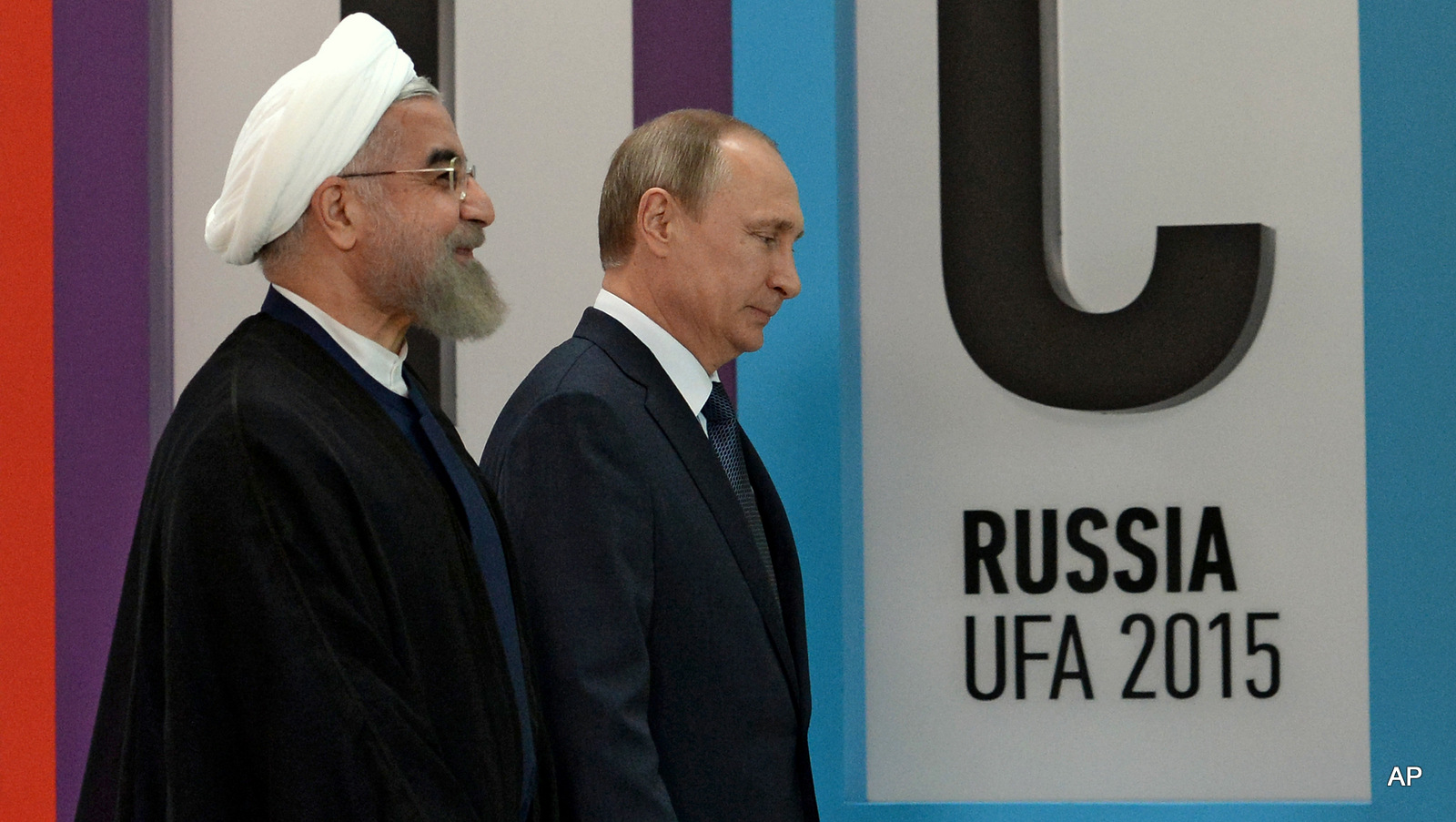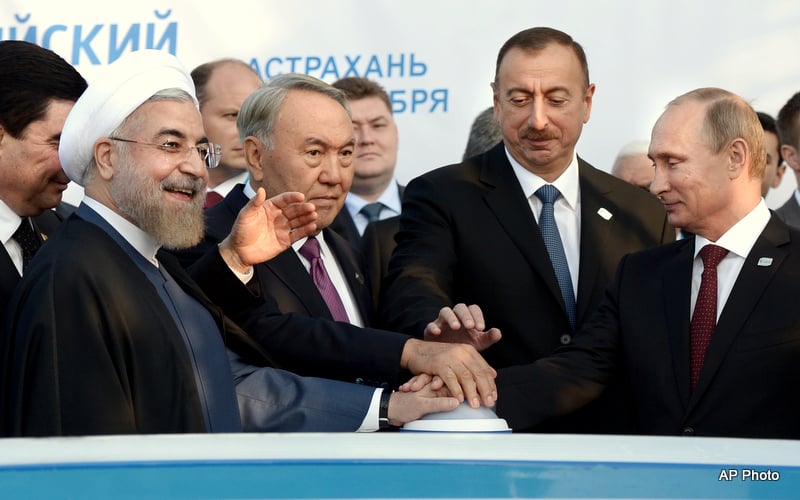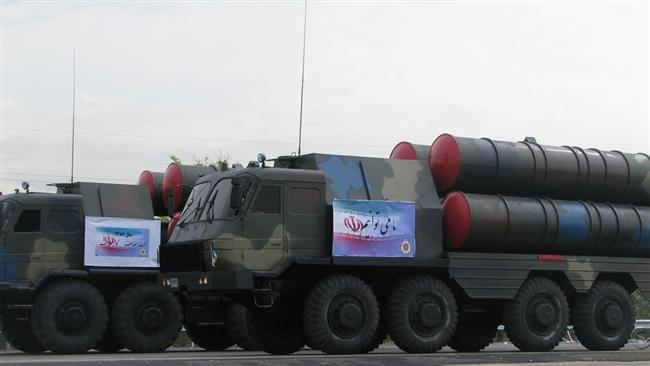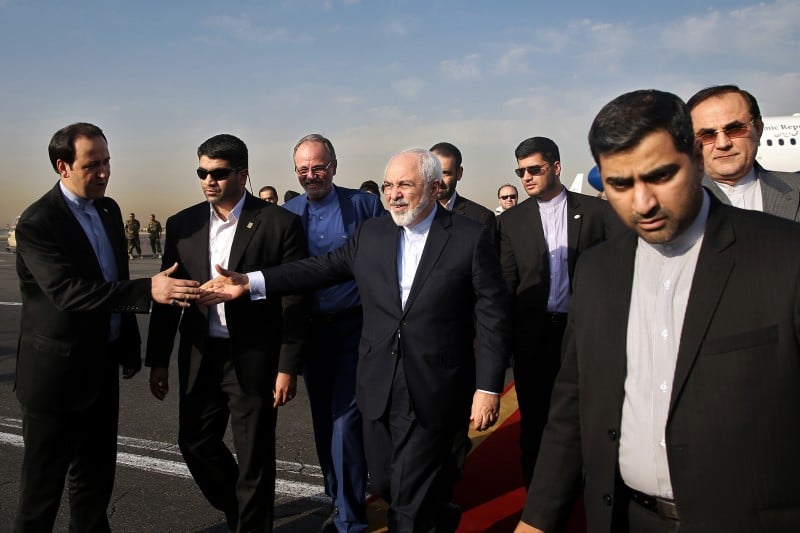The implications of the recent Iranian nuclear deal extend far beyond centrifuges and uranium enrichment. Russia, which has long played tensions between Tehran and Washington to its own ends, may know this better than anyone.
MONTREAL — Tehran and Washington have both been constrained by their own post-1979 rhetoric about one another. Even after a final nuclear deal was signed in Geneva on Tuesday, officials in Tehran and Washington say they are not normalizing ties. Generally, however, both sides have long wanted to improve relations without making any concessions, giving up their respective strategic goals, or publicly abandoning their ideological positions.
It should not be forgotten that Washington and Tehran started a secret dialogue via diplomatic backchannels in the Sultanate of Oman in 2013, shocking their allies and enemies alike. The U.S. threats to attack Syria in August 2013 may have been aimed at gaining traction and leverage in the secret bilateral talks between Tehran and Washington.
According to Banafsheh Keynoush, a former translator to four Iranian presidents and the Iranian reformist lawyer Shirin Ebadi, Tehran has long wanted to rekindle trade with Washington.
Journalist Gareth Porter makes a similar claim, even arguing that Iranian officials deliberately used uranium enrichment to normalize ties with Washington. Writing for Middle East Eye on Wednesday, Porter contends that during Bill Clinton’s second term in the Oval Office, “Iranian strategists began to discuss the idea that Iran’s nuclear programme was its main hope for engaging the hegemonic power.” There was even a letter faxed by Iran for a “grand bargain” in 2003 that Mohammad Javad Zarif, Iran’s foreign minister, acknowledges as an Iranian response to a misleading signal from a third party claiming to speak on Washington’s behalf.
Russian President Vladimir Putin walks with Iranian President Hassan Rouhani, left, in Ufa, Russia, Thursday, July 9, 2015.
Getting down to business
It is no coincidence that as the nuclear talks progressed, chatter about a resumption of business ties between Iran and the United States flared up on Wall Street and in Tehran’s bazaars. When a final deal was announced in Vienna this week, it was also announced inside Iran that a “special plan” has been drafted to export petrochemical products to the U.S., among other places, according to Iran’s Mehr News Agency. The announcement was not hearsay, but made by the prominent Iranian Association of Petrochemical Industry Corporations.
The plan to export Iranian petrochemicals is just the tip of the iceberg, though. Tehran Times reports that on May 23, Gholamreza Shafei, the head of the Iranian Chamber of Commerce, Industries, Mines, and Agriculture, “said the Iranian government has given the green light to private business owners to forge trade ties with their American counterparts.” He also acknowledged that the establishment of a joint Iranian-U.S. chamber of commerce had been discussed for about ten months up until that point.
In fact, talk of establishing a joint Iranian-U.S. chamber of commerce was disclosed by the Iranian government’s Islamic Republic News Agency (IRNA) in 2013. IRNA reported that discussions about a joint Iranian-U.S. chamber of commerce started at the same time that Washington and Tehran began direct talks in 2013.
The convenience of normalizing trade ties between Iran and the U.S. is that the process could unfold with little public sign of normalization. Iran-U.S. trade and business transactions can ensue without a normalization of diplomatic relations and without any significant changes in the public perception of Iran-U.S. ties in either country. Rhetoric on both sides could, more or less, be kept in place while trade prospers, and hardliners on both sides opposing rapprochement could be kept at bay as well.
Changing geostrategic parameters between the US, Russia, and Iran
Hostilities between the U.S. and Iran have been something that other international actors have long taken advantage of for their own agendas. Tehran and Washington have been cognizant of this.
The Russian government has used the tensions between Tehran and Washington as a card for its own negotiating strategies a number of times. Moscow, however, has always consciously tried not to cross a certain line when playing on Iranian-U.S. differences as it’s sought concessions from Washington. Moscow has never wanted to weaken Iran or let Washington subdue Tehran. The Russians and Iranians both know very well that their security is organically interlocked.
With the normalization of U.S. and Iranian ties and the conciliatory approach that Washington and Tehran took in 2013, the leveraging of Russia’s bilateral ties with Iran against the U.S. is a path Moscow essentially can no longer pursue. The Kremlin realizes this, and since 2013 it has taken earnest steps to cement Russo-Iranian ties as a strategic partnership that could mirror the Sino-Russian partnership.
This includes taking steps to establish greater confidence and trust between Moscow and Tehran. Moscow has also atoned for former Russian President Dmitry Medvedev’s decision to halt the shipment of S-300 missile air defense systems to Iran in 2010 by revoking his ban on the systems’ delivery, upgrading systems, and offering to sell the superior Antey-2500 to the Iranian military if Tehran withdraws its lawsuit against Rosoboronexport for failing to deliver the S-300 at the Geneva-based Conciliation and Arbitration Court of the Organization for Security and Cooperation in Europe (OSCE).
Non-nuclear bilateral talks between Tehran and Washington have undoubtedly included some type of U.S. effort to turn the Iranians against the Russians, especially now that the European Union needs an alternative energy supplier to replace the Russian Federation. Even when the U.S. pushed the Russians in 2010 to cancel the S-300 deal that Moscow made with Iran in 2007, it was celebrating the fact that the Iranian government took Russia to the OSCE’s Court of Conciliation and Arbitration in 2011 seeking $4 billion in compensation for a breach of contract by the Kremlin.
From left, President of Turkmenistan Gurbanguly Berdymukhamedov, President of Iran Hassan Rouhani, President of Kazakhstan Nursultan Nazarbayev, Azerbaijan’s President Ilham Aliev and Russian President Vladimir Putin press a symbolic button to release some young belugas (white sturgeons) to the Volga river, during the Caspian Summit in Astrakhan, Russia, Monday, Sept. 29, 2014.
The information war against Russia
The U.S. mainstream media and intelligentsia working within the constellation of U.S. interests have launched an anti-Russian information campaign emphasizing that Iran and Russia are “allies of convenience” and that the Russo-Iranian partnership will not last. They claim Russia is the biggest loser in a nuclear deal between Iran and the P5+1 (China, France, Russia, the United Kingdom, and the U.S., plus Germany).
Their talking points decidedly point to the negative aspects of the history between Russia and Iran and emphasize that Moscow and Tehran will be competitors in the energy market, especially in Europe. They also emphasize that the Russians have fearfully rushed to secure trade agreements with Iran before the Iranian market opens for trade to the U.S. and Western Europe. They presuppose that Iran will prefer U.S. and Western European corporations to Russian ones because the Russian ones are not as advanced and the Russian technology is outdated.
At the same time, another narrative claims Russia and Iran are trading places in the international community. This transformation has gradually been described over the last decade as Russia being like Gaullist France, an independent part of the West agitating against Washington. Descriptions then began to paint Russia in terms of the People’s Republic of China when tensions flared between Moscow and NATO during and after the Russo-Georgian war over South Ossetia and the missile shield in Europe. Russia was described as separate from the West, like China, but co-existing.
After EuroMaidan in Ukraine, Russia slowly began being described as the new Iran, a country involved in a hostile relationship with the West. This is why the U.S. government’s Radio Free Europe claims: “After decades as an isolated rogue state, Iran appears to be finally coming in from the cold. And after decades of pretending to be a partner to the West, Russia has gone rogue.”
A lot of these assessments are either polemics or sophistry. One widely circulated Reuters article by Agnia Grigas and Amir Handjani claims that Russia will be the “big loser” in a nuclear deal with Iran, but it’s riddled with mistakes and presuppositions.
The authors, both experts in the energy sector, were not aware that the BP Statistical Review of World Energy had announced that Iran held the world’s biggest natural gas reserves with a volume of 1202.4 trillion cubic feet. Nor were Grigas, an expert on Russia and the post-Soviet space, who has consulted for the Eurasia Group, and Handjani aware that it was the Chinese empire — not Iran — that had lost the most territory to Russia in the past.
Putting those errors aside, the Reuters article stipulates that the “Russo-Iranian alliance has been more a marriage of convenience than a genuine partnership.” This is wishful rhetoric from the Washington Beltway. The authors supported this assertion by claiming that, “Russia uses Iran as a geopolitical foothold in the energy-rich Persian Gulf and to poke a finger in the eye of U.S. allies in the region.”
“In return, Iran takes advantage of Moscow’s veto power at multinational forums such as the United Nations,” they continued.
They further presume that, “[a]n Iran that is engaged with the West in areas such as energy, trade and peaceful nuclear power generation would no longer see Russia as protector of its interests.”
Russia has no foothold in the Persian Gulf, and there is no evidence that Moscow has used Tehran to hassle any of Washington’s regional allies in the Middle East. Inversely, the Kremlin has no interest in instigating problems with U.S. allies in the Middle East, like Israel and Saudi Arabia, and instead wants to trade with them and lure them away from Washington.
On the other hand, however, the Iranians will never let themselves be manipulated to do the bidding of another international actor and have always worked as the protectors of their own interests without depending on other countries. There has not been a long track record of Russia using its veto for Iran.
Nor is Iran in the same position as its ally Syria, as Tehran does not have any overt fears and concerns with the U.N. Security Council; this is why Iran was not shaken by any of the U.N. Security Council resolutions passed against it.
Bavar-373s, S-300s, and the UN weapons sanctions
On the other side of the spectrum in the information war between Moscow and Washington, sectors of the Russian media point out that the opening of the Iranian market will mean big business for Russian corporations — including Russian arms manufacturers, the Russian nuclear industry, and the Russian energy sector.
Iranian Bavar-373s.
Some Russian experts, however, have warned of Iranian infidelity. In June, the Russian news agency TASS reported that Vladimir Sazhin, senior research fellow in the Russian Academy of Sciences, argued: “Iran does not care at all about Russia’s interests. It needs money and at some future date it will be able to offer considerable competition to Russia, and not in Europe alone: on the oil market, in two or three years from now, and on the gas market, in five to seven years.”
Reports emerging from both the U.S. and Russia are generally exaggerated or they misunderstand Iran. They also fail to recognize that Iran manufactures most of its own military equipment, including ballistic missiles, submarines, combat jets, tanks, helicopter, drones, and radar detectors.
It is correct that the dropping of the weapons sanctions would give a boost to the Russian weapons industry. The boost, however, will not be a business bonanza because the Iranian military is not dependent on Russia for its security or equipment.
As mentioned before by this author, even if the Iranians purchase some of their military hardware from the Russians, Tehran has a “policy of military self-sufficiency and primarily manufactures its own weapons.” When Moscow refused to repair three Russian-made Kilo class submarines because Iran was not willing to send them to Russia, the Iranian military did the overhauls itself. The Iranian military even contends that its Bavar-373 air defense system is more or less the equivalent of the Russian S-300.
Iran’s arms industry is “a dynamic and modern industry that is moving ahead; we may supply our needs from friendly states, but we basically believe that our deterrent power should be based on a home-grown technology,” Brigadier General Ali Shadmani, the Iranian Armed Force’s deputy chief of staff, told the Fars News Agency in April, in response to reports that the S-300 was going to significantly safeguard Iranian air space as if Iran could not protect its own skies. Shadmani went on to explain that Tehran did need the missile defense system in 2006 and 2007, and the deal for the S-300, which was solicited by Russia, was a sound move at the time.
He further noted that Iran still wanted the system, even though it is producing the Bavar-373, because “production is not fast enough to satiate” the needs of the Iranian military.
It is very likely that the main goal for the Iranians for dropping the arms sanctions was to export their own weapons. U.N. Security Council Resolution 1747, unanimously adopted in 2007 with the consent of both China and Russia, actually kept the Iranian arms industry from competing on the weapons market with the arms manufacturers of the P5+1. Iranian President Hassan Rouhani even addressed the Iranian public, saying all of Tehran’s objectives were fulfilled in Vienna under the terms of the final nuclear deal, even though the U.N. arms embargo against Tehran will partially remain for a few years.
Iran’s Foreign Minister Mohammad Javad Zarif, who is also Iran’s top nuclear negotiator, center, shakes hands with an official upon arrival at the Mehrabad airport in Tehran, Iran, Wednesday, July 15, 2015. Zarif and his entourage returned to Tehran on Wednesday morning, a day after Iran and the West reached a historic nuclear deal. (AP Photo/Ebrahim Noroozi)
While Iran trades with the West, Eurasia will remain its strategic depth
Although there is jockeying to enter the Iranian market, the various assessments in sympathy or hostility toward Russia or the U.S. disregard two important facts. First, it is Tehran that decides who it trades with and who it does not trade with. Second, the Iranians are not limited in their post-Vienna options for trade partners.
Iran has made trade deals with Russia on the basis of preferential treatment for a secured strategic partner and ally. Moscow and Tehran are working to build an insulated strategic alliance in Eurasia, and they aim to establish a bond similar to the one that China and the Russian Federation have.
While the Iranians will not give up their strategic ties with Russia, they will work in their best interests and hope for a balanced strategic partnership with Moscow. Tehran seeks a balanced approach with Russia in a mutually beneficial relationship with the Russian Federation that does not reduce Tehran to becoming subordinate to Moscow. Iran will engage Western European and U.S. businesses, and make deals with them in place of Russian businesses where it is needed and deemed appropriate.
Despite any blossoming of trade with the U.S. and Western Europe, Tehran will maintain its strategic depth in Eurasia. This is why the Iranians have lobbied and applied for Iran to become a full member of the Shanghai Cooperation Organization alongside Russia and China.
Moreover, Tehran does not trust Washington. As has been stated during the negotiations, the nuclear agreement is not built on trust but on verification and reciprocity.
What of the war clouds?
From the start, the Iranian nuclear dossier was political in nature. Gareth Porter writes that as a “militarily weak but politically influential regional ‘middle power,’” Iran essentially prompted the nuclear standoff as leverage to engage the U.S. with the goal of normalizing ties with Washington.
The nuclear standoff, however, was a crisis manufactured by Washington to rein in the Iranians and the “Axis of Resistance,” comprised of Syria, Hezbollah, Hamas, and other regional actors in the Middle East. Allegations that the Iranian nuclear energy program was not peaceful were a convenient tactical charade used by Washington and its allies to try to pressure Iran. The objective of this was to rein in Tehran to restructure the Middle East as part of Washington’s broader unipolar roadmap of targeting the Russians and Chinese and establishing control over Eurasia.
Beijing, Moscow, Tehran, and Washington all have contingency plans for different scenarios. The chances of betrayal do exist and the Iranians are prepared for this. In 2009, the Brookings Institute even recommended that Washington create the illusion that it gave the Iranians a chance to negotiate before attacking them “to ensure the logistical support the operation would require and to minimize the blowback from it.”
The Pentagon should “strike only when there is a widespread conviction that the Iranians were given but then rejected a superb offer — one so good that only a regime determined to acquire nuclear weapons and acquire them for the wrong reasons would turn it down,” the Brookings Institute report “Which Path to Persia?” advises.
For months, while Foreign Minister Zarif and his negotiating team of Iranian deputy foreign ministers were trying to draft a deal with U.S. Secretary of State John Kerry and the P5+1 or EU3+3, Iranian military commanders were making parallel statements about being ready for war and the need for military upgrades. In fact, Ayatollah Ali Khamenei gave specific directions to the Iranian government and military to increase spending on June 30. Khamenei has ordered them to renew their preparedness for conflict, too.
At the conclusion of the nuclear negotiations in Vienna, the supreme leader told President Rouhani that certain members of the sextet that Zarif had inked the final nuclear agreement with were untrustworthy and had to be watched carefully. This mistrust in itself ensures that Iran will take a balanced approach toward the U.S. and Russia.
For Mint Press News by Mahdi Darius Nazemroaya. Originally published on July 17, 2015.
http://www.mintpressnews.com/author/mahdi-darius-nazemroaya/




